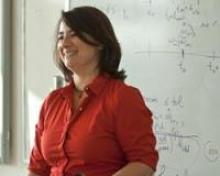 An exacting nanosecond jolt of electricity can briefly open a cell’s wall, allowing for the delivery of drugs or DNA. This procedure — called electroporation — is widely used in biology, biotechnology and medicine, including cancer treatments.
An exacting nanosecond jolt of electricity can briefly open a cell’s wall, allowing for the delivery of drugs or DNA. This procedure — called electroporation — is widely used in biology, biotechnology and medicine, including cancer treatments.
Why the cell’s wall opens, however, has remained a mystery until now.
UC Merced applied math Professor Mayya Tokman and her collaborators have figured out what is going on at the nanoscale and recently published their findings in PLOS ONE. The open access peer-reviewed journal is part of the Public Library of Science, a nonprofit public publisher. Tokman’s coauthors include Professor Michael Colvin, graduate student Jane HyoJin Lee, research Professor Thomas Vernier at Old Dominion University and Vernier’s graduate students at University of Southern California.
Using complex computer models, the research team discovered that the electric charge causes water molecules to rearrange themselves to create a water bridge across the cell’s wall connecting the inside and the outside of a cell.
“It’s such a basic thing — water — that controls this process,” Tokman said. “It’s interesting that this is happening with the cells that make up our bodies or any other biological tissue.”
This discovery is just one example of how UC Merced’s research is shedding light on important questions that remain in medicine and health.
In the past, researchers believed electricity might cause lipid molecules that make up the cell wall to move and create holes, but had little evidence to show it. Additionally, a cell wall has many components, including nanomotors and ion channels.
“It’s very difficult to figure out what’s going on,” Tokman said. “The cell membrane is a zoo, plus the creation of holes in the cell wall cannot be observed directly through a microscope because the openings are too small.”
In fact, the only way researchers know a cell membrane opens is by exposing the cell to dyes that fluoresce only when they come in contact with chemicals inside the cell.
Experimental researchers do not have a way to determine the strength and the duration of electric pulses, which is needed to control the quantity and the size of the openings in a cell wall.
For example, electrochemotherapy is a therapeutic cancer treatment in which electricity puncture’s a tumor’s cell walls, so drugs can be delivered directly in to the perforated cell. This procedure is known to be more effective than regular chemotherapy and is already used in several European countries. But the protocols of the electric pulse delivery in electrochemotherapy are set by experimental trial and error, Tokman said.
Understanding how water behavior drives cell breaching makes it possible to create a theory that is more predictive.
Tokman plans to continue her research to develop estimates of how strong and how long electric pulses have to be to open up a membrane to exactly the desired degree. Such theory could be valuable in many applications including reducing the dose of drugs in electrochemotherapy without compromising its effectiveness.
Media Contact



